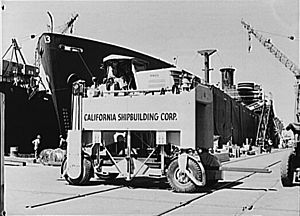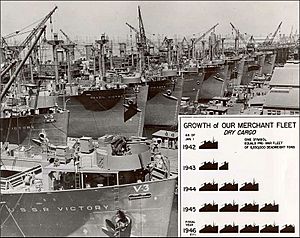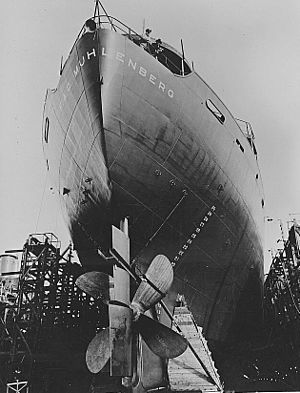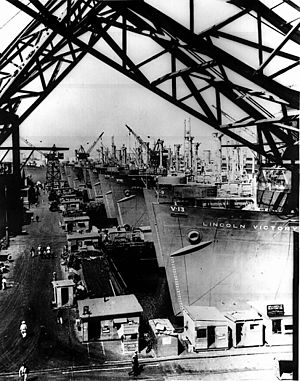California Shipbuilding Corporation facts for kids
The California Shipbuilding Corporation, often called Calship, was a huge shipyard that built many ships during World War II. They built 467 ships, including Liberty ships and Victory ships. These ships were very important for carrying supplies and troops during the war.
Building Ships for War: Calship's Story
The Calship shipyard was built from scratch on Terminal Island in Los Angeles, California. This was part of America's huge effort to build ships quickly for World War II. Before this, Los Angeles hadn't built a large ship in 20 years. But by late 1941, shipbuilding became the second biggest industry in the area.
Starting Up: A New Shipyard for America
Calship began building Liberty Ships in May 1941. The United States Maritime Commission and the United States Navy gave them many contracts. This brought a lot of shipbuilding work to Los Angeles. The shipyard covered 175 acres. It started with 8 building areas, called ways, and later grew to 14.
Working Together: The Calship Crew
About 40,000 men and women worked at Calship. Most of them had no shipbuilding experience before joining. They worked together to build 467 ships in just five years. These ships were known as the "Liberty Fleet." They were designed to be built fast and at a low cost.
Breaking Records: Fast Ship Production
Thirteen months after starting, Calship broke a record. They delivered 15 Liberty Ships in June 1942. They delivered 111 ships in total that year, more than any other shipyard in the U.S. In June 1943, they broke the record again with 20 ships in one month. Then in December 1943, they delivered 23 ships!
A City on Stilts: Building on Marshy Ground
The Calship yard was known as "the city built on invisible stilts." It was built on marshy ground. Workers had to drive 57,000 piles into the mud to support the artificial land. They even started building ships before the docks for finishing them were ready!
Keeping Workers Informed: The Calship Log
The shipyard published a newspaper called "The Calship Log." It came out twice a month for "Calshippers" and "Calshipperettes." The newspaper shared updates on the war effort and safety rules. It also had information about fun activities, public transport, and war bonds. A special "Victory Edition" was printed on September 27, 1945.
The End of an Era: Calship Closes
After the war ended, the government canceled its contracts with Calship. Shipbuilding slowed down. Calship closed in September 1945. They launched their last Victory ship exactly four years after the first one. Calship was ranked 49th among U.S. companies for its military production during World War II.
In 1947, another company took over the Calship site. This company recycled metal. Interestingly, 55 of the Liberty and Victory ships that Calship built were later scrapped at the very same site.
| Quantity | Design | Type | Use |
|---|---|---|---|
| 306 | EC2-S-C1 | Liberty ship | Cargo transport |
| 30 | Z-ET1-S-C3 | Liberty ship | Tanker (carries liquids) |
| 32 | VC2-S-AP3 | Victory ship | Cargo transport, 8,500 hp |
| 30 | VC2-S-AP5 | Haskell class | USN attack transport (carries troops and equipment) |
| 69 | VC2-S-AP2 | Victory ship | Cargo transport, 6,000 hp |
Surviving Ships: A Glimpse into History
Two ships built at Calship are still around today as museum ships: the SS American Victory and the SS Lane Victory. The SS American Victory is in Tampa, Florida. The SS Lane Victory is in Los Angeles. You can visit them for tours, and sometimes they even sail!
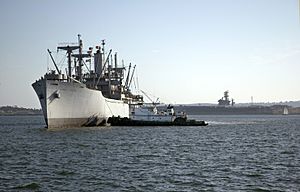
Famous Ships Built by Calship
- SS Oshkosh Victory
- SS Tufts Victory
- SS U.S.S.R. Victory
- SS Luray Victory
- USS Arenac
- SS Alamo Victory
- USS St. Mary's (APA-126)
- SS Carroll Victory
- SS Gainesville Victory
- SS Joplin Victory
- USNS Dalton Victory (T-AK-256)
- USS Attala
- SS Clara Barton
- USS Botetourt
- SS Colby Victory
- SS Mexico Victory
- USS Kenton (APA-122)
- SS Sharon Victory
- USS Hendry (APA-118)
- USS Lanier (APA-125)
- USS Hinsdale (APA-120)
- USS Kittson (APA-123)
- USS Don Marquis (IX-215)
- SS Carlos Carrillo
- USS Bosque (APA-135)
- SS Leland Stanford
- USS Betelgeuse (AK-260)
- SS Edward Eggleston


